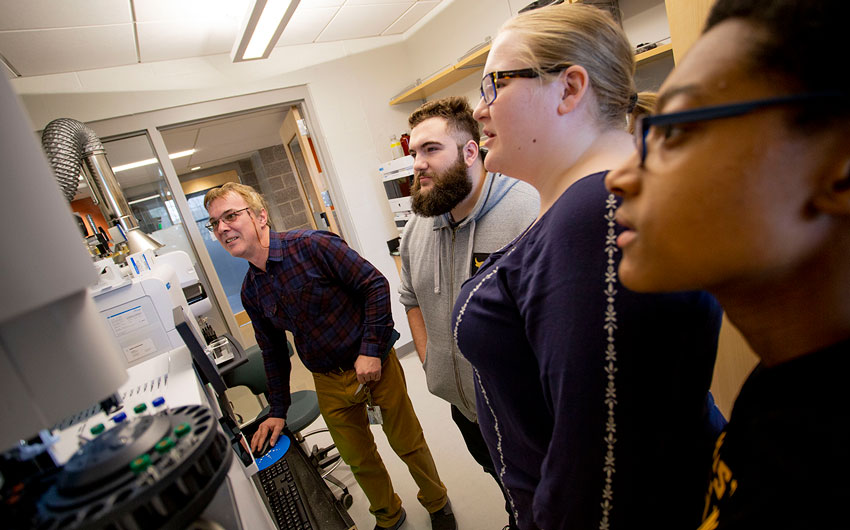
TOPICS:
The Science and Research Center in the Learning Commons is now home to a series of new state-of-the-art analytical instruments that will allow students to uniquely identify and quantify organic compounds at the part-per-billion level, which is equivalent to measuring one drop of ink in a giant tanker truck.
Supported by a gift from the George I. Alden Trust, the Gas Chromatograph Mass Spectrometer(GC-MS) and Nuclear Magnetic Resonance Spectrometer (NMR) are two of the new instruments that will allow students to isolate and identify organic molecules, practicing the same type of data analysis led by chemists and biochemists in the field. Philanthropic donations of this caliber are instrumental in helping the College equip facilities with cutting-edge teaching technology and tools. Students studying chemistry, biochemistry, biology, public health, nursing, and other related disciplines will now have access to the state-of-the-art technology to perform experiments as part of the College’s laboratory teaching curriculum.
“The technology represented by these new instruments is routinely used today for medical research, pharmaceutical product development, or in forensic labs for trace analysis,” says Dr. Sandor Kadar, lecturer in the department of science and math. “After graduating, it is likely that students will encounter one or more of these technologies, whether in graduate or medical school or in industry.”
The new technology will support both the undergraduate science curriculum and independent research projects. Led by Kadar and Dr. Marie Turner, professor of chemistry, Dylan Saraiva ’21 is among a group of students conducting independent research using the new GC-MS to analyze the chemical components of electronic cigarette products. While the dangers of regular tobacco use are well documented, little is known on the health risks of using vaping devices. The industry has recently come under scrutiny for its youth-centered marketing appeal, as more than one in four American teens has tried vaping, according to the US Centers for Disease Control and Prevention.
“When the e-cigarettes originally came out, they were marketed as a healthier alternative to regular cigarettes, but new injuries to young people using these devices have brought that into question,” says Saraiva. “This research is important because I think it’s shocking how many teenagers are using these products without really knowing what is in them or the potential danger they cause.”
International tobacco company Phillip Morris produces a PMI-58 list, which accounts for 58 harmful and potentially harmful constituents. Preliminary data from the research with the GC-MS instrument indicates as many as 100 compounds in their vaping products.
The research this new technology makes possible is only beginning, and Kadar anticipates conclusions will follow a comprehensive, multi-year research analysis. Ultimately, he hopes, in addition to having students participate in industry conferences, to publish the results in an academic journal, which presents a unique opportunity for student researchers. “Publishing research is rarely seen at the undergraduate level.”
As a senior, Jason Truong ’20 won’t be at Curry to see the research through to its completion but is working hard this semester to establish the sample method that other students will reproduce moving forward. Having contributed to the early work across multiple semesters, Truong speaks positively of the hands-on research experience. “It’s interesting to experiment with different methods. If something didn’t work, we work to find out why and try a different approach next time. I’ve had to invest myself wholly in the project, and it’s been a great experience.”
For Kadar, it’s that exposure to the trial and error of the scientific method that is invaluable. “In science education, it is imperative that students are given a chance to participate in authentic, meaningful research beyond the “cookbook” experiment model. These new instruments are yet one more way we are making that possible at Curry.”